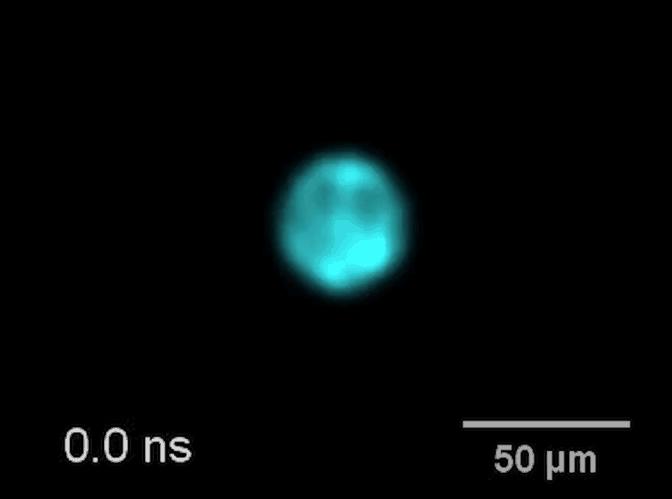Ultrafast camera takes 1 trillion frames per second of transparent objects and phenomena

A shockwave created by a laser striking water propagates in slow motion, as captured by a new ultrafast photography technology. Credit: Caltech
A little over a year ago, Caltech's Lihong Wang developed the world's fastest camera, a device capable of taking 10 trillion pictures per second. It is so fast that it can even capture light traveling in slow motion.
But sometimes just being quick is not enough. Indeed, not even the fastest camera can take pictures of things it cannot see. To that end, Wang, Bren Professor of Medical Engineering and Electrical Engineering, has developed a new camera that can take up to 1 trillion pictures per second of transparent objects. A paper about the camera appears in the January 17 issue of the journal Science Advances.
The camera technology, which Wang calls phase-sensitive compressed ultrafast photography (pCUP), can take video not just of transparent objects but also of more ephemeral things like shockwaves and possibly even of the signals that travel through neurons.
Wang explains that his new imaging system combines the high-speed photography system he previously developed with an old technology, phase-contrast microscopy, that was designed to allow better imaging of objects that are mostly transparent such as cells, which are mostly water.
Phase-contrast microscopy, invented nearly 100 years ago by Dutch physicist Frits Zernike, works by taking advantage of the way that light waves slow down and speed up as they enter different materials. For example, if a beam of light passes through a piece of glass, it will slow down as it enters the glass and then speed up again as it exits. Those changes in speed alter the timing of the waves. With the use of some optical tricks it is possible to distinguish light that passed through the glass from light that did not, and the glass, though transparent, becomes much easier to see.
“What we've done is to adapt standard phase-contrast microscopy so that it provides very fast imaging, which allows us to image ultrafast phenomena in transparent materials,” Wang says.
The fast-imaging portion of the system consists of something Wang calls lossless encoding compressed ultrafast technology (LLE-CUP). Unlike most other ultrafast video-imaging technologies that take a series of images in succession while repeating the events, the LLE-CUP system takes a single shot, capturing all the motion that occurs during the time that shot takes to complete. Since it is much quicker to take a single shot than multiple shots, LLE-CUP is capable of capturing motion, such as the movement of light itself, that is far too fast to be imaged by more typical camera technology.
In the new paper, Wang and his fellow researchers demonstrate the capabilities of pCUP by imaging the spread of a shockwave through water and of a laser pulse traveling through a piece of crystalline material.
Wang says the technology, though still early in its development, may ultimately have uses in many fields, including physics, biology, or chemistry.
“As signals travel through neurons, there is a minute dilation of nerve fibers that we hope to see. If we have a network of neurons, maybe we can see their communication in real time,” Wang says. In addition, he says, because temperature is known to change phase contrast, the system “may be able to image how a flame front spreads in a combustion chamber.”
###
The paper describing pCUP is titled “Picosecond-resolution phase-sensitive imaging of transparent objects in a single shot.” Co-authors include Taewoo Kim, a postdoctoral scholar in medical engineering, and Jinyang Liang and Liren Zhu, both formerly of Caltech.
Funding for the research was provided by the National Institutes of Health.
Media Contact
All latest news from the category: Power and Electrical Engineering
This topic covers issues related to energy generation, conversion, transportation and consumption and how the industry is addressing the challenge of energy efficiency in general.
innovations-report provides in-depth and informative reports and articles on subjects ranging from wind energy, fuel cell technology, solar energy, geothermal energy, petroleum, gas, nuclear engineering, alternative energy and energy efficiency to fusion, hydrogen and superconductor technologies.
Newest articles

“Nanostitches” enable lighter and tougher composite materials
In research that may lead to next-generation airplanes and spacecraft, MIT engineers used carbon nanotubes to prevent cracking in multilayered composites. To save on fuel and reduce aircraft emissions, engineers…

Trash to treasure
Researchers turn metal waste into catalyst for hydrogen. Scientists have found a way to transform metal waste into a highly efficient catalyst to make hydrogen from water, a discovery that…

Real-time detection of infectious disease viruses
… by searching for molecular fingerprinting. A research team consisting of Professor Kyoung-Duck Park and Taeyoung Moon and Huitae Joo, PhD candidates, from the Department of Physics at Pohang University…





















